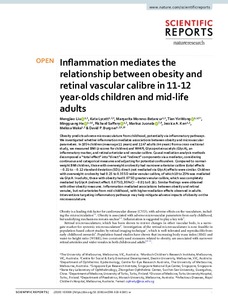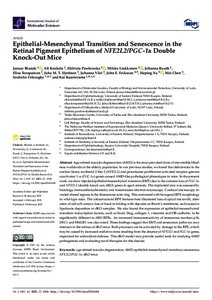Retinal plasticity in the context of a partially rescued retinitis pigmentosa mouse model
Raunioniemi, Peppi (2022-03-28)
Retinal plasticity in the context of a partially rescued retinitis pigmentosa mouse model
Raunioniemi, Peppi
(28.03.2022)
Julkaisu on tekijänoikeussäännösten alainen. Teosta voi lukea ja tulostaa henkilökohtaista käyttöä varten. Käyttö kaupallisiin tarkoituksiin on kielletty.
avoin
Julkaisun pysyvä osoite on:
https://urn.fi/URN:NBN:fi-fe2022050532879
https://urn.fi/URN:NBN:fi-fe2022050532879
Tiivistelmä
Retinitis pigmentosa (RP) is a major cause of hereditary blindness and visual disability. The prevalence of RP is estimated to be 1/4000, affecting approximately 2.5 million people worldwide. RP is a very slow-progressing disease, and its symptoms start usually during adolescence. Mutations in over 70 different genes can cause photoreceptor cell degeneration leading to retinitis pigmentosa. A common RP-related gene is PDE6B which encodes a β-subunit of PDE6-enzyme which has a crucial function in rod-mediated vision.
No cure is available currently for RP patients. Treatment options are few, but the most promising one is gene therapy. Since retinal gene therapy is delivered by a single sub-retinal injection, it does not rescue all the diseased photoreceptor cells. The impact of the non-rescued photoreceptor cells on the rescued ones is not fully understood. This remains a challenge for the therapy.
The project aimed to study the retinal morphology and the function of the retinal pigment epithelium (RPE) in 48-week-old diseased (RP) and partially rescued mice. Pde6bST/WT mice have a functional Pde6b allele and were used as a control in the experiments. Pde6bST/ST mice have a loxP-flanked stop cassette in the intron 1 of both loci of the Pde6b gene. The stop cassette contains multiple polyadenylation signals which prevent gene expression. Pde6bST/ST exhibit progressive rod degeneration. In Pde6bST/ST Pax6αCre mice, stop cassettes are partially removed by the Cre recombinase which is expressed under a Pax6α promoter. Both Pde6b alleles are functional in the distal retina whereas the non-recombined retina in the center remains mutant.
Retinal sections were stained with multiple antibodies to study the retinal morphology. RPE morphology was studied by quantifying fluorescence images from RPE wholemounts. Apoptotic cell death in the RPE cells was studied by using a commercial TUNEL assay. In normal physiology, RPE cells phagocytose photoreceptor cell outer segments and this process was studied by using an ex vivo assay.
According to the results, the partially rescued retina of Pde6bST/ST Pax6αCre showed signs of retinal remodelling. This can be seen as beneficial for the retinal gene therapies conducted by a single injection if the partially rescued retina can regenerate and expand the rescued area. The diseased retina of Pde6bST/ST showed large-scale retinal degeneration and revealed heterogeneity of the RPE.
No cure is available currently for RP patients. Treatment options are few, but the most promising one is gene therapy. Since retinal gene therapy is delivered by a single sub-retinal injection, it does not rescue all the diseased photoreceptor cells. The impact of the non-rescued photoreceptor cells on the rescued ones is not fully understood. This remains a challenge for the therapy.
The project aimed to study the retinal morphology and the function of the retinal pigment epithelium (RPE) in 48-week-old diseased (RP) and partially rescued mice. Pde6bST/WT mice have a functional Pde6b allele and were used as a control in the experiments. Pde6bST/ST mice have a loxP-flanked stop cassette in the intron 1 of both loci of the Pde6b gene. The stop cassette contains multiple polyadenylation signals which prevent gene expression. Pde6bST/ST exhibit progressive rod degeneration. In Pde6bST/ST Pax6αCre mice, stop cassettes are partially removed by the Cre recombinase which is expressed under a Pax6α promoter. Both Pde6b alleles are functional in the distal retina whereas the non-recombined retina in the center remains mutant.
Retinal sections were stained with multiple antibodies to study the retinal morphology. RPE morphology was studied by quantifying fluorescence images from RPE wholemounts. Apoptotic cell death in the RPE cells was studied by using a commercial TUNEL assay. In normal physiology, RPE cells phagocytose photoreceptor cell outer segments and this process was studied by using an ex vivo assay.
According to the results, the partially rescued retina of Pde6bST/ST Pax6αCre showed signs of retinal remodelling. This can be seen as beneficial for the retinal gene therapies conducted by a single injection if the partially rescued retina can regenerate and expand the rescued area. The diseased retina of Pde6bST/ST showed large-scale retinal degeneration and revealed heterogeneity of the RPE.
Samankaltainen aineisto
Näytetään aineisto, joilla on samankaltaisia nimekkeitä, tekijöitä tai asiasanoja.
-
Inflammation mediates the relationship between obesity and retinal vascular calibre in 11-12 year-olds children and mid-life adults
Melissa Wake; Jessica A. Kerr; Mingguang He; Tien Yin Wong; Kate Lycett; Margarita Moreno-Betancur; Mengjiao Liu; Richard Saffery; Markus Juonala; David P. Burgner -
Epithelial-Mesenchymal Transition and Senescence in the Retinal Pigment Epithelium of NFE2L2/PGC-1 alpha Double Knock-Out Mice
Blasiak Janusz; Koskela Ali; Pawlowska Elzbieta; Liukkonen Mikko; Ruuth Johanna; Toropainen Elisa; Hyttinen Juha M T; Viiri Johanna; Eriksson John E; Xu Heping; Chen Mei; Felszeghy Szabolcs; Kaarniranta KaiAge-related macular degeneration (AMD) is the most prevalent form of irreversible blindness worldwide in the elderly population. In our previous studies, we found that deficiencies in the nuclear factor, erythroid 2 like ... -
Cardiovascular health and retinal microvascular geometry in Australian 11-12 year-olds
Mengjiao Liu; Kate Lycett; Melissa Wake; Mingguang He; Jessica A. Kerr; Richard Saffery; Markus Juonala; Tim Olds; Terry Dwyer; David P. Burgner; Tien Yin WongTraditional retinal microvascular parameters (smaller arteriolar and greater venular caliber) are associated with cardiovascular risk factors, pre-clinical vascular phenotypes and clinical cardiovascular events in adults. ...



